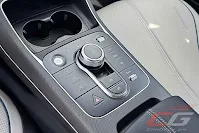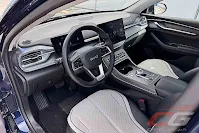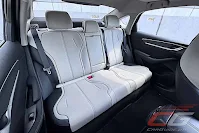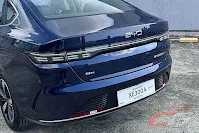BYD Cars Philippines is making a killing with these plug-in hybrids of theirs. Recognizing the value proposition offered by the Sealion 6 DM-i (read our review), people simply lapped up the compact SUV. Soon, they followed that up with the second member of their DM-i (Dual Motor Intelligent) range, the Seal 5 DM-i, and in the coming weeks, a third, with the Sealion 5 DM-i. Going back to the Seal 5 DM-i, it represents the Chinese car brand’s entry into yet another competitive segment—the B or sub-compact sedan. Can lightning strike twice, or did BYD just run out of new tricks?
Since we had the Seal 5 DM-I for a week, we tested its all-electric range first, depleted it, topped it up, and then switched over to hybrid mode for the remaining days. With a sizeable 18.3-kWh battery pack, BYD says it should go up to 115 kilometers on electrons alone. Although it fell short, with the display indicating 98.2 kilometers (average speed 14 km/h), it’s still good enough for two and a half days of our regular home to office commutes. Not bad.
Compared to other plug-in hybrids, the Seal 5 DM-i defaults first to pure EV mode. Because of this, it’s the electric motor that does all the heavy lifting, and true enough, even quick full throttle jabs won’t coax the combustion engine on. However, its EV output is limited to about 96 kW (130 horsepower), so keeping that right foot nailed down for a couple of seconds, will signal the DM-i that you need more pace. At this time, it’ll switch the gas engine on to help you tap the full 197 horsepower (144 kW) output. The switchover is near imperceptible save for a very slight vibration felt through the steering wheel.
The same thing can be said when the Seal 5 DM-i is on HEV mode. The combustion engine does turn on and off more often, and that’s either to help boost outputs or to keep the blade battery topped up. Even so, most of the work’s done by the electric motor resulting in a combined 30.3 km/L figure (average speed 14 km/h) based on the on-board computer.
Typical of BYDs, the Seal 5 DM-i isn’t dynamically impressive. Wheelspin might as well be its middle name as it produces a prodigious amount of it. Oddly enough, it does it in a variety of situations. Full throttle launches? Wheel spin. Partial throttle launches with a bit of steering angle? Wheel spin. Accelerating from a U-turn on a greasy road? Wheel spin. An over nannying stability control takes a big chunk of edge off, but not before the steering wheel squirms for a split-second. Moreover, the ride is far too soft and pillowy to the point that it feels boat-like at times. Build quality is good and NVH is well-controlled, however, it’s odd that pebbles and even splashes of water echo and ping through the wheel wells a bit too much. Flipping through the vehicle menu reveals different Steering and Brake Pedal modes (Comfort and Sport), alas it’s just about adding or subtracting the level of effort. Even in a straight line, the light steering requires tons of micro corrections which may tire out drivers particularly on very long drives. Ditto with the brakes which bite well, but have this wooden feel.
The exterior design of the Seal 5 DM-i can be polarizing. Personally, I have nothing against the chrome braces look, but some have found it over-the-top especially since it’s echoed in the lighting elements and even wheels. The rear-end’s more subdued, although one feature that often escapes people is the separate rear quarter window. A rare design feature among B-segment sedans, it’s a mark of a luxury car if BYD’s to be believed. What you make of that statement is up to you.
Inside, the cabin borrows heavily from the Sealion 6 DM-i, and if you’re getting used to BYD’s cars of late, the overall interface is similar. There are some nice bits—the soft dash topper, stalks, and center console buttons, door cards, and seats, but there are also some less stellar bits—the steering wheel switches, rearview mirror, and power window switches.
The driver’s seat only moves in six ways, but there’s still a good level of adjustment and easy enough to get comfortable in. Compared to the Sealion 6 DM-i which has instrument cluster nestled in a traditional binnacle, this one uses a tablet-like screen like the setup in the Seagull or Atto 3. The 8.8-inch screen is easy enough to decipher and remains legible even in direct sunlight. For those of us who prefer to sit low, the upper edges may be obstructed by the steering wheel, so a slight adjustment may be required. There are two designs and color schemes to choose from too.
At the center, the Seal 5 DM-i has a 12.8-inch infotainment screen which rotates 90 degrees for as long as you’re in the default Google-based BYD OS (smartphone mirroring like CarPlay or Android Auto only works in landscape mode). The menu is easy enough to navigate and the buttons easy enough to hit. Most used functions of the climate control are fixed at the bottom of the screen, but, interestingly, it’s locked out whenever the camera or parking sensors are engaged. As always, the 4G-enabled BYD Assistant is a breeze to use and the screen also recognizes multi-finger gestures—like three-finger swipes control the temperature (up and down) and fan speed (left and right).
BYD calls the Seal 5 DM-i a sub-compact sedan, and that’s true when you factor in P 948,000 starting price (P 1,198,000 for this Seal 5 DM-i Premium). However, a gander at its dimensions—4,780 mm in length and 2,718 mm in wheelbase puts it squarely in the compact or C-segment sedan category. True enough, there’s no shortage of space with generous amounts of room front or back. In particular, the rear passengers get a fully-flat floor thanks to the exhaust pipe being routed to the left side of the car. Open the cargo hold, and at 450 liters, it’s almost at par dimensionally, at least, with a compact SUV. However, the depth is deceptively shallow as our personal experience with a crushed takeout box and the overly protruding trunk hinges tell. There’s also no spare tire here, but a mobility kit with a sealant and a portable pump hidden underneath.
Feature-wise, the Seal 5 DM-i is solid, especially considering its price point. It doesn’t offer the fancy stuff we’ve been accustomed to in other Chinese brands, BYD included of late, but it’s still well-featured all things considered. Dual-zone climate control with rear AC vents? Check. A sunroof (a normal one, not the panoramic kind)? Check. Powered driver’s seat? Check. Wireless charger? Check. A 360-degee camera with front and rear sensors? Check. A full set of airbags, ABS with EBD, stability control, and tire pressure sensors? Check. For as long as you won’t complain about the lack of ADAS functionality, an auto-dimming rearview mirror, and rain-sensing wipers, this boy pretty much nails it. And again, we’re talking about a P 1,148,000 PHEV sedan here.
Going back to the original question, does the second member of BYD’s DM-i family impress as much as the Sealion 6 DM-i? Yes, it does. While it doesn’t change the game nor does it blow away the competition as much as its compact SUV does, being the B-segment’s first PHEV offering and at its price point, is enough to get people talking about. While it’s clearly speced and de-contented to help it achieve a more affordable price point, at least it doesn’t sacrifice on BYD’s core strength which is the electrified powertrain. Again, enthusiasts will probably scuff at the Seal 5 DM-i for its horrid driving dynamics, but for those who’re looking for a great Point A to Point B daily driver, it ticks all the right boxes. And for a vast majority of buyers out there, that’s good enough.
|
2025 BYD Seal 5 DM-i Premium |
|
| Bottom Line | |
| Pros | Spacious interior, affordable electrified performance, fuel economy. |
| Cons | Lackluster dynamics with wheelspin for days, clearly featured to a price (compared to other Chinese cars). |
| TL;DR | It won't excite enthusiasts, but it's a great Point A to Point B commuter car. |
| Ownership | |
| Year Introduced | 2024 |
| Warranty |
6 years / 150,000
kilometers 8 years / 160,000 kilometers (High-Voltage Battery) |
| The Basics | |
| Body Type | Sub-compact Sedan |
| Seating | 5 |
| Engine / Drive | F/F |
| Under the Hood | |
| Displacement (liters) | 1.5 |
| Aspiration | Normally Aspirated |
| Fuel Delivery | EFI |
| Layout / # of Cylinders | I4 |
| Maximum Output (PS @ rpm) |
106 197 (Combined) |
| Maximum Torque (Nm @ rpm) |
135 325 (Combined) |
| Fuel / Min. Octane | Gasoline / ~91 |
| Transmission | CVT |
| Cruise Control | Yes |
| Fuel Economy (km/L) @ Ave. Speed (km/h) |
76.9 km/L @ 14 km/h, 7.24 km/kWh @ 14 km/h |
| Fuel Tank Size (L) |
48, 18.3 kWh |
| Dimensions and Weights | |
| Length (mm) | 4,780 |
| Width (mm) | 1,837 |
| Height (mm) | 1,495 |
| Wheelbase (mm) | 2,718 |
| Curb Weight (kg) | 1,620 |
| Suspension and Tires | |
| Front Suspension | Independent, MacPherson Strut |
| Rear Suspension | Torsion Beam |
| Front Brakes | Vented Disc |
| Rear Brakes | Disc |
| Parking Brake | Electronic, w/ Auto Hold |
| Tires |
Giti GitiComfort F22
Advanztech 215/55 R 17 V (f & r) |
| Recommended Tire Pressure (PSI) | 36, all |
| Wheels | Alloy |
| Safety Features | |
| Airbags | 6 |
| Anti-Lock Brakes (ABS) | Yes, with EBD |
| Traction / Stability Control | Yes |
| Parking Sensors | Yes, Front & Rear |
| Parking Camera | Yes, 360 |
| Front Seatbelts | 3-pt ELR w/ pre-tensioners x 2 |
| Rear Seatbelts | 3-pt ELR x 3 |
| ISOFIX Child Seat Anchor | Yes |
| Advanced Driver Assist System | None |
| Other Safety Features |
Hill Start Control System Tire Pressure Monitoring System |
| Exterior Features | |
| Headlights | LED |
| Fog Lamps | Rear (LED) |
| Light Operation | Automatic |
| Wiper Operation | Variable Intermittent |
| Tailgate | Manual |
| Interior Features | |
| Steering Wheel Adjust | Tilt/Telescopic |
| Steering Wheel Material | Leather |
| Seating Adjustment (driver) | Electric, 6-way |
| Seating Adjustment (front passenger) | Manual, 4-way |
| Seating Surface | Leather |
| 2nd Row | 60/40 Split-Fold Sliding |
| 3rd Row | None |
| Sunroof | Yes |
| Multi-Information Display / Size | Yes, 8.8-inch |
| Convenience Features | |
| Power Steering | Yes |
| Power Door Locks | Yes |
| Power Windows | Yes |
| Power Mirrors | Yes, w/ Fold |
| Rear View Mirror | Day/Night |
| Proximity Key | Yes |
| Climate Control | Dual Zone, w/ Rear Vents |
| Audio System |
Stereo USB Type A Bluetooth |
| Wireless Charger | Front |
| Infotainment Display / Size | 12.8-inch |
| Smartphone Connectivity |
Apple CarPlay (Wireless) Android Auto (Wireless) |
| # of Speakers | 8 |
| Steering Controls | Yes |


























It's really small. If you are 5'10 and above. (I'm 6'). I couldn't fit in the front and back lmao.
ReplyDeleteGreat to hear your opinion on this. At 170 cm in height, I had no issues.
DeleteThe interior packaging seems off when compared to Corolla and Civic. This feels more like Mazda3 when getting in and out. I'm 5'8" and it's easy for me to hit my head on the A-pillar/body frame.
DeleteThe seat is perched high upfront even at its lowest setting. I didn't find any issue with it, but it could be, depending on how you enter the Seal 5.
DeleteVs nissan kick?
ReplyDeleteKicks isn't as efficient or quick as the BYD. It's showing its age already.
Deletedownside about PHEV in the philippines is that the price of EV charging is high AF. its almost priced same as gas car
ReplyDeletePlus you have to note the triple maintenance for PHEV
Battery + Motor + Engine, cost of ownership is definitely higher and the efficiency is not helping due to high electricity cost
Unless you charge at home. It's just P 12 per kWh, P 14 in the latest Meralco advisory.
DeleteI fail to understand this 'triple maintenance' concern. The battery needs no maintenance apart from checking its health (you get a free replacement if it goes under a specific threshold). If you're talking about paying out of pocket when beyond warranty, BYD says that if you buy it now then by the time the warranty on the battery runs out (8 years) a full replacement will cost you 100k (and I believe this because battery tech has gotten so much cheaper already), it's not cheap but that newly bought 100k battery will have another 8 year warranty of its own again. Then you have electric motors which are incredibly more simple than an internal combustion engine. And finally, the engine of PHEVs like this? They are tuned to run at their most efficient state since they are just generating power which means that over its lifetime it is a very un-abused engine.
DeleteTo show this even more, the PMS of the Seal 5 goes; 1st PMS free at 1k km or 1 month, then 2nd PMS is 3k km or 3 months then after that it's every 20k km or 1 year. Compare that to the PMS cycles of ICE cars and that will help you better understand the costs.
HEV vehicles savings is max at 50% (40% on average) compared to ICE vehicles. But with PHEV you can increase the savings to as much as 71% by charging at home as electricity is way more cheaper than gasoline. Then you still has a chance to save more by as much as 99% on fuel by going solar. Gone are the days that you watch the weekly changes in the price of gasoline and be happy when the price drop by at least P1/liter and then sad again when it increase by P2 per liter or more.
ReplyDeleteNice fuel efficient vehicle even without ADAS in it
ReplyDeleteI am surmising that a quick upgrade of the tires to a better compound / tread might well decrease the annoying wheel spin. The Atto 3 is shod with Contis for 2025, and word on the street says it made a world of difference.
ReplyDeleteIt's not just the brand of tire, but the new Atto 3 that we got has been speced with thicker tires too. That probably helped as well.
DeleteThis comment has been removed by a blog administrator.
ReplyDeleteI love wheelspins. It always bring a smile to my face. The pillowy suspension can be cured by aftermarket. I say its a nice car not pretending what its not.
ReplyDelete